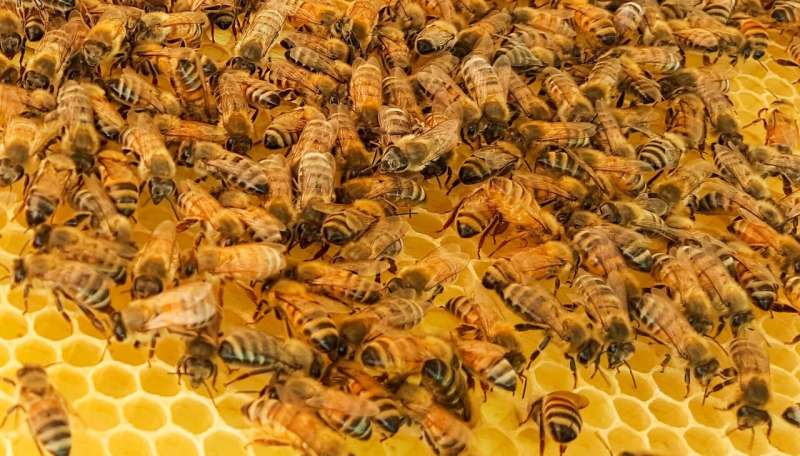This article has been reviewed according to Science X's editorial process and policies. Editors have highlighted the following attributes while ensuring the content's credibility:
fact-checked
peer-reviewed publication
trusted source
proofread
Not lazy at all: Honey bee drones can be most active members of the colony

Sometimes it is worthwhile to look at the details, to study aspects that seem to be uninteresting or were previously ignored, and see noteworthy phenomena come to light. This has been the experience of honeybee researchers from the Cluster of Excellence Center for the Advanced Study of Collective Behavior (CASCB) at the University of Konstanz and the Max Planck Institute of Animal Behavior.
In a recently published study in Animal Behavior, they showed that male honey bees (drones), long considered lazy, are (at times) the most active members of the colony.
"Whenever there is something that people say is uninteresting, or that has been skipped over, then I think those are the most useful and interesting places to go, simply because you might be the first person to actually look and see." This is the working motto of Michael L. Smith, an affiliate member of the Max Planck Institute of Animal Behavior and the Cluster of Excellence CASCB and currently a professor at Auburn University.
To enable such a discovery, he encouraged Louisa Neubauer, a bachelor's student at that time, to take a closer look at drones, the male reproductive members of honey bee colonies. The results were so surprising that they were recently published in the journal Animal Behavior.
Drones play a crucial role in the reproductive success of the colony. The males leave the hive only for the mating flights, in which the drones try to mate with a virgin queen. Besides that, the drones spend their lives in the hive as part of the colony. Therefore, they are thought of as "lazy and dull." "Nevertheless, how drones behave in the hive and how they integrate with the rest of the colony remains unclear," says Neubauer who is now a doctoral candidate at the University of Bern.
"We were already tagging and tracking the workers, so it seemed like an easy and obvious extension to tag and track some of the drones," says Smith. So, individually marked drones were introduced to a colony living in a glass covered observation hive. Some drones got little paper tags containing an individual code as well as a code for the orientation on the thorax.
With the BeesBook, a tracking system developed by Tim Landgraf's group at the Free University of Berlin, Neubauer could follow the movement and position of each individually marked drone throughout their life by decoding the tags. The results were a real surprise: "From time to time, these 'lazy' drones are temporarily the most active individuals in the entire colony," says Neubauer.
Drones have synchronized hyperactivity periods
For Neubauer, it was exciting to see that, next to the described laziness or immobility of drones, the drones have synchronized hyperactivity periods, in which they are the fastest individuals in the colony. The research team found that this hyperactivity period coincides with the flight period of drones, and the periods and synchronization are influenced by both external factors and the exchange of social information. "Overall, these findings are amazing, since they show how drones adapt their behavior to their task by limiting their energy consumption to a certain activity window," says Neubauer.
So far, it was known to researchers that drones base the timing of their mating flights on the weather. "But, looking more precisely inside the colony, the start and end times of their hyperactive periods are more synchronized than we would expect by cueing on the weather alone," says Jacob Davidson, postdoctoral researcher at the Max Planck Institute of Animal Behavior and affiliate member of the CASCB. "This suggests that the drones communicate to make a synchronized collective decision when to leave the nest." How exactly this communication between the drones takes place is a topic for future research.
Saving energy for the mating flights
"The results of this study demonstrate that drones adapt their in-hive behavior to their task as male gametes of the colony," summarizes Louisa Neubauer. "First of all, the drones restrict their energy consumption by limiting their activity to a certain period of the day matching the time of mating flights while staying relatively immobile the rest of the day. Second, the drones are located in the nest as required for their developmental stage, but without disturbing the work of other individuals."
The results highlight that drones adapt to their task and, even with being lazy, they contribute to the honeybee colony by reducing their own energy use. This also shows that drones integrate into the honeybee colony and adapt their behavior to maximize the colony's success.
More information: Louisa C. Neubauer et al, Honey bee drones are synchronously hyperactive inside the nest, Animal Behaviour (2023). DOI: 10.1016/j.anbehav.2023.05.018
Journal information: Animal Behavior , Animal Behaviour
Provided by University of Konstanz




















